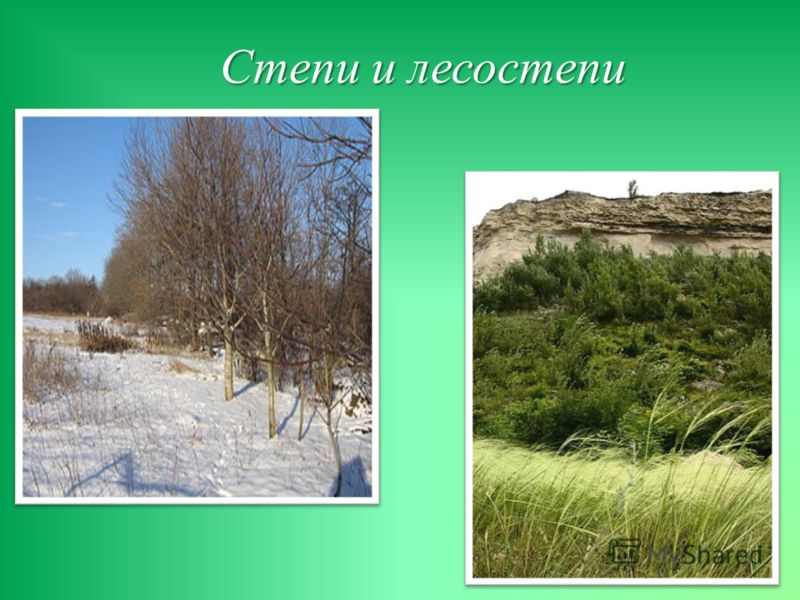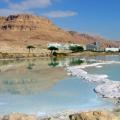Within temperate zone 1/3 of the territory is located North America... Thermal conditions and humidification are not uniform. Due to the increase in the annual value of the radiation balance by an average of 6 KJ / cm 2 for each degree of latitude, latitudinal zonality is clearly traced.
The largest territory within the temperate zone is occupied by natural complexes of the forest zone, including subzones of taiga, mixed, broad-leaved and western oceanic coniferous forests.
Taiga subzone stretches from the Atlantic coast in the east and the Pacific coast in the west. It is characterized by moderately humid, sometimes severe snowy winters and warm, short summers. The average minimum temperature is 25 ° C, the amount of precipitation is 400-700 mm per year. Permafrost is not ubiquitous. The vegetation cover of the taiga is characterized by dark coniferous forests. Tree stand central regions Taiga is mainly formed by three types of trees: black spruce, white spruce, balsam fir. American larch and paper birch, prevailing in clearings or burnt-out areas, as well as several types of poplar are widespread. Along with spruce and spruce-fir forests, forests of white pine, or Weymouth pine, red pine and Banks pine are widespread. The taiga of North America is in many ways similar to the taiga of Europe.
Podzolic soils are formed under the canopy of coniferous trees, as in the Eurasian taiga.
The taiga is not uniform throughout. The western part of the subzone, located in the Mackenzie River basin, is distinguished by a sharply continental and dry climate; it is dominated by dry sparse forests with light needles (pine, white spruce, larch), and in the southern part there are small-leaved species, in particular aspen. The prevailing soils are gray forest soils.
The southern part of the eastern sector of the temperate zone is the territory adjacent to the Great Lakes, and most of the Appalachian mountains are landscapes subzones of mixed and deciduous forests. The climate is moderately warm and rather humid. The winter period is characterized by intense cyclonic activity, causing frequent precipitation, mainly in the form of snow. There is also a lot of precipitation in summer, as moisture comes here from the Gulf of Mexico. Thermal winter conditions are an important landscape-forming factor.
The northern half of this area is occupied by subzone mixed forests. In mixed forests, among broadleaf forests, the dominant position is occupied by various types of maple: sugar, red, silver. There are also large-leaved beech, American linden, American elm, ash, yellow birch; rock oak is widespread. Conifers grow together with deciduous trees: Canadian hemlock, thuja, pine, spruce, fir, larch - typical representatives of taiga vegetation.
In the most humid eastern part of the Central Plains and in the foothills of the Appalachians, subzone of deciduous forests, which reaches the subtropical belt, deciduous trees begin to be supplanted by evergreens. Pine predominates among conifers on outwash terraces or steep rocky slopes of the root banks of river valleys. On the Appalachian plateau oak and beech are found, in the east of the Central Plains - oak and some relict plants, in particular tulip tree, hickory, liquandambr, etc. The main forest-forming species include oak - white, red and large-fruited, hickory, linden, beech, chestnut , deciduous magnolia, black walnut, western sycamore. Dense undergrowth, lianas, various grasses complement the richness of deciduous forest vegetation. It is associated with the fertility of the accompanying brown forest soils.
Landscapes subzones of western oceanic coniferous forests are formed on the territory of the Cordillera mountain belt under the strong influence of the Pacific air masses. This subzone includes only mountainous landscapes, which differ significantly from the plain ones even in the lowest belt of mountains. In different parts of this region, four types of mountain landscapes are distinguished: meadow-tundra; meadow-tundra oceanic; forest-tundra continental; forest meadow.
The Cascade Mountains, the Canada Coast Ridge, the northern United States Coast Ranges, the Rocky Mountains, the most humid but unshaded lower western slopes are home to extremely productive Douglas pine forests (Weymouth pine). Douglas Iya (Douglas fir, or pseudo-tree) is one of the largest trees in the world, their height sometimes exceeds 100 m, their diameter reaches 1.5-2 m. The densest forests are characteristic of the coast. It is dominated by thuja and western hemlock. Closer to the peaks and on the eastern slopes prevail different types pines (yellow and sugar), forming light, grassy pine forests.
At the upper border of the forest, at an altitude of 1500-2000 m, rare forests of spruce, fir and larch grow, and higher - tall-grass grasses and sedge subalpine meadows, turning into alpine low-grasses.
Prairie subzone takes western part Central plains and is a transitional subzone between deciduous forests and steppes. Compared to the forest-steppe, the prairies receive much more solar heat, the amount of precipitation reaches 800 mm.
Among the many dozens of species of grasses, blue and little bearded vultures prevail. Among other cereals, there are less tall ones - Indian grass, meadow bluegrass. Of the flowering plants, white and pink immortelles, blue astragalus, light yellow groundwort, and yellow goldenrod are widely represented.
The peculiarities of the climate and vegetation cover have left their mark on soil-forming processes. As a result of the withering away of plant organisms, a large amount of organic matter remains in the soil every year, replenishing the reserves of humus. However, the thickness of the humus layer and the humus content are less here than in chernozems. This is due to the fact that in prairie soils, as in brown forest soils, the abundance of heat and moisture generates rapid humus mineralization. All these signs make it possible to distinguish the soils of this subzone into a special type - prairie chernozem soils. The area of distribution of these soils corresponds to the center of the US corn belt, one of the main agricultural areas of the country (Iowa). Prairie chernozem soils are formed on loesses. There are four types of prairie, which gradually replace each other from east to west as the dryness increases. Meadow prairie located in the east of the zone and resembles a forest-steppe. The grass stand is high and closed (bearded grass, feather grass, wheatgrass, forbs). Shrubs and single trees, mainly oak, are found in the beams. Typical prairie forms a strip elongated from north to south, the axis of which almost coincides with the meridian of 100 ° W. e. The dryness is higher than in the meadow prairie. Here, along with bearded grass and feather grass, Gramma grass, bison grass, asters, phloxes, "Indian summer", etc. are typical.
Mixed (dry) prairie differs in a smaller amount of forbs: gramma grass, bison grass, keleria prevail. The sod of the bearded man stands out.
Sod grass prairie is located to the west of the mixed and also occupies elevated sandy hillocks in the area of typical and dry prairies. The grass sods are sparse. This type of prairie forms the transition from prairie to steppes.
The prairies are almost completely plowed up. The prairie area is now one of the most important agricultural areas in North America.
To the west of the Central Plains, annual precipitation drops to 600 mm per year and evaporation begins to exceed precipitation. Here is formed steppe zone, which occupies the territory of the Great Plains from the province of Alberta (Canada) in the north to the state of Texas (USA) in the south. Thus, the typical steppes stretch from north to south along the foothills of the Cordilleras. They are also found in separate areas on the inner plateaus of the Cordilleras.
Most of the territory is occupied by dry steppes, located mainly within the Great Plains; they cover most of the Columbia Plateau and the south of the Fraser Plateau. Annual precipitation amounts to 400 mm. This does not provide sustainable crop yields, so a significant part of the land is not plowed up. From the herbaceous vegetation, there are local grasses - Gramma grass, bison grass, and fescue-like fescue. Wormwood grows on sandy soils. The soils of dry steppes - chestnut chernozems and chestnut soils of North America - differ from European ones in their low humus content.
Typical steppes occupy a narrow strip between forest-steppes and dry steppes; 550-600 mm of precipitation falls annually. Undulating black earth plains cut by ravines and gullies, once overgrown with local species of fescue and wheatgrass, bearded vulture, are plowed up almost everywhere.
The zone of deserts and semi-deserts occupies a smaller area compared to the vast areas that they cover in Eurasia. Deserts and semi-deserts in the temperate zone of North America occupy the driest part of the Columbia Plateau and the entire territory of the Great Basin. Annual precipitation in the continent's deserts barely reaches 250 mm. The scarcity of precipitation is due to the influence of the Cordilleras, which retain moisture on the western slopes of the ridges. The complex orography, the presence of numerous short ridges lead to the fact that the landscapes of deserts and semi-deserts do not form clearly isolated territories, as on the plains of Central and Central Asia, but are distributed in separate areas. Most of the territory has no drainage into the ocean, which leads to salinization. The main background of the vegetation cover is created by thickets of black wormwood bushes. This plant is more than 1 m tall and has a powerful root system. Absorbing soil moisture, wormwood accumulates a lot of salts, which, after the dying off of plant organisms, remain in the upper layers of the gray-brown soils prevailing here. On solonetzic soils, thickets of swans are widespread. The largest plant in the deserts of the temperate zone is saxaul, a shrub up to 1.5 m high.
Geographic belt- the largest zonal division geographic envelope, encircling the globe in the latitudinal direction. Geographic zones correspond climatic zones... Each geographic zone is distinguished by the integrity of climatic conditions.
The globe is subdivided into the following geographic areas and belts:
- North Polar Zone - North of the Arctic Circle
- arctic belt
- Northern Temperate Zone - between the Arctic Circle and the Tropic of Cancer
- southern temperate zone
- Hot Zone - Between the Tropics of Cancer and Capricorn
- southern tropical belt
- equatorial belt
- northern tropical belt
- South Temperate Zone - between the Tropic of Capricorn and the Antarctic Circle
- northern temperate zone
- South Polar zone- south of the Antarctic Circle
- antarctic belt
The following belts are also distinguished on the borders:
- two subequatorial (north and south)
- two subtropical (northern and southern)
- subarctic
- subantarctic
In the Hot Zone, the sun is at its zenith at least once a year - at the edges of the tropics during the summer solstice, and at the equator during the equinoxes. It is the hottest (hottest) part of the earth and has two annual seasons: dry and wet. The hot zone includes most of Africa, South India, South Asia, Indonesia, New Guinea, northern Australia, Central America and North South America In the two Temperate Zones, the sun is never directly at its zenith, the climate is temperate (mild), slowly changing from warm to cold. There are four seasons in these zones - spring, summer, autumn and winter. The Northern Temperate Zone includes the UK, Europe, North Asia and North America. The South Temperate Zone includes southern Australia, New Zealand, southern South America and South Africa. In the two polar zones, there is a phenomenon such as a polar day and a polar night - at the borders of the zones during the solstice the sun does not rise for 24 hours, while at the poles, the day "lasts one year" - six months of sunshine and six months of night. The polar zones are the coldest parts of the earth, covered with ice and snow. The North Polar Zone (Arctic) includes northern Canada and Alaska, Greenland, northern Scandinavia, northern Russia and arctic ice... The South Polar Zone (Antarctica) consists of the continent of Antarctica; other closest continents - south cape Chile and Argentina as well New Zealand.
10.The role of living matter in development crust, atmosphere, hydrosphere.
At the highest level of the hierarchy of biosystems is the global ecosystem - biosphere – the totality of all living organisms and their ecological environment within the planet. The "biosphere" was first used by the Austrian geologist E. Suess (1873), defining the space of organic life on Earth. An outstanding role in the development of the theory of the biosphere belongs to the Russian scientist V.I. Vernadsky. In his classic work "Biosphere" (1926), he essentially rediscovered this concept, giving it the meaning and status of a global system in which all living organisms interact with each other and with environment, which have a decisive influence on planetary geochemical and energy transformations. The biosphere is a part of the globe within which life exists. It is a shell of the Earth, consisting of the atmosphere, hydrosphere and the upper part of the lithosphere, which are interconnected by complex biochemical cycles of migration of matter and energy. Vernadsky (1868-1945), one of the founders modern look on the biosphere, defined it as the outer shell of the Earth, the area of distribution of life, the basis of which is the interaction of living and inert matter.According to modern concepts, the biosphere is a kind of shell of the Earth, containing the entire set of living organisms and that part of the planet's matter that is in continuous exchange with these organisms. In a biosphere that is very complex in composition, structure and organization, a relatively small number of main components can be distinguished:
- living matter Is a set of bodies of living organisms that inhabit the Earth, regardless of their systematic affiliation. The total weight of living matter is estimated at 2,400 billion tons (dry). According to V.I. Vernadsky's definition, living matter is one of the most powerful geochemical forces of our planet;
- biogenic substance - These are chemical compounds that have arisen as a result of the vital activity of organisms. In this case, the resulting chemical compounds may not be part of the bodies of organisms ( coal, peat, humus, chalk, limestone, oil, etc.);
- inert substance - This is a substance that is formed without the participation of living matter (rocks of the earth's crust of inorganic origin, water, air components);
- bioinert substance – these are products of the processing of rocks and sedimentary rocks by organisms;
- cosmic matter .
The biosphere in its main features can be characterized by the individual shells that it covers: the lower atmosphere, the hydrosphere, and the upper lithosphere. Atmosphere Is a gaseous envelope surrounding the Earth. The atmosphere is considered to be the area around the Earth in which the gaseous medium rotates together with the Earth as a whole. The exchange of matter between the Earth and space takes place through the atmosphere. The Earth receives cosmic dust and meteorite material, loses the lightest gases: hydrogen and helium. The Earth's atmosphere is penetrated through and through by the powerful radiation of the Sun, which determines the thermal regime of the planet's surface, causes the dissociation of atmospheric gas molecules and the ionization of atoms. The atmosphere has a layered structure, which is primarily determined by the features of the vertical temperature distribution: the troposphere (up to 10 km), the stratosphere (10- 47 km), mesosphere (47-80 km), thermosphere (80-1000 km). At altitudes over 1000 km, there is an exosphere, from where atmospheric gases are dispersed into world space. All structural parameters of the atmosphere (temperature, pressure, and density) have significant spatio-temporal variability: latitudinal, annual, seasonal, and diurnal. The composition of the atmosphere includes nitrogen (78 , 08% by volume), oxygen (20.95%), argon (0.93%), carbon dioxide (0.03%), neon, helium, methane, krypton, hydrogen, xenon, water vapor, ozone, etc. An important variable component of the atmosphere is water vapor. Spatio-temporal variability of its concentration ranges from 3% in the tropics to 2 · 10 -5% in Antarctica (y the earth's surface). The bulk of water vapor is concentrated in the troposphere, and its concentration rapidly decreases with height. The average content of water vapor in a vertical column of the atmosphere in temperate latitudes is about 15-17 mm of the "layer of precipitated water", that is, the layer of condensed water vapor will have such a thickness. One of the most important components of the atmosphere is ozone About 3... Ozone is mainly concentrated in the stratosphere, where its formation and decomposition is associated with the absorption of ultraviolet radiation from the Sun, which is destructive for living organisms: O + O 2 = O 3... The main amount of ozone is concentrated at altitudes of 20-25 km. The average monthly values of the total ozone content vary depending on the latitude and the season and amount to the ozone layer thickness in the range of 2.3-5.2 mm at ground-based pressures and temperatures. The ozone layer - the "screen" is extremely important for the preservation of life on Earth. Hydrosphere - the water shell of the Earth. Due to its high mobility, waters penetrate everywhere into various natural formations. They are in the form of vapors and clouds in earthly atmosphere, form oceans and seas, exist in a frozen state in the high-mountainous regions of the continents and cover the polar land areas in the form of powerful ice shells. Precipitation they penetrate into the strata of sedimentary rocks, forming groundwater. Water is capable of dissolving many substances in itself, therefore any water in the hydrosphere can be considered as natural solutions of varying degrees of concentration. The purest atmospheric waters contain 10-50 mg / L of dissolved substances, and seawater - up to 35 g / L. The hydrosphere is in close relationship with the lithosphere (groundwater), the atmosphere (vaporous moisture) and the living matter of the biosphere, into which it enters. as an obligatory component (a person is 70% water). According to V.I. Vernadsky, water stands out in the history of our planet, but it plays an important role in the geological history of the Earth. Water is one of the factors in the formation of physical and chemical environment, the climate on our planet, the emergence of life on Earth. If the water of the hydrosphere is evenly distributed over the surface of the planet, it will cover it with a layer of 3000 m. But the average thickness of the earth's crust is ten times the average thickness of the hydrosphere, and the radius of our planet is 2100 times The overwhelming majority of natural waters make up the World Ocean (94%), which is a unique natural system of the biosphere. A grandiose process of exchange and transformation of the energy and matter of our planet takes place in it. At the same time, various physical, chemical and biological processes are combined, forming a single nature of the ocean. Since the formation of the ocean, its nature has changed under the influence of various natural processes: solar radiation, geological and geochemical factors and, most importantly, under the influence of biological processes. Biological processes have manifested themselves and are manifested in the development of living organisms, in biological productivity and sediment formation throughout the entire area of the ocean floor, in the formation of various kinds of organogenic silts. Sea (oceanic) water is a natural solution containing an average of 35 g of dissolved substances in 1 liter of water ... In general, we can assume that in sea water all chemical elements of D.I. Mendeleev. However, the predominant part of the dissolved substances is composed of a few chemical elements: O, H, Cl, Na, Mg, S, Ca, K, Br, C, Sr, B, F, Si, Rb, Li, N, P, J. Some of the elements, despite their low concentration, play an important role in ocean chemical processes and in marine organisms. In this respect, the leading role belongs to nitrogen, phosphorus and silicon, which are assimilated by living organisms, and their concentration in seawater is controlled by the growth and reproduction of marine animals and plants. One feature of ocean water should be noted - the main ions are characterized by a constant ratio throughout the entire volume of the World Ocean. This indicates the stability of the dynamic equilibrium between the amount of dissolved substances entering the ocean from the surface of the continents and their deposition. ocean water there are dissolved gases that are formed during the exchange of gases with the earth's atmosphere, with the participation of biochemical processes in the ocean and at its bottom, during degassing of the mantle in the regions of rift valleys and underwater volcanoes. So, if in the Earth's atmosphere there is the most nitrogen and oxygen in mass and a little carbon dioxide, then in the dissolved atmosphere of the ocean, the basis in mass is carbon dioxide, which is almost 100 times more than in the earth's atmosphere. Oxygen in the ocean is almost 100 times less and very little nitrogen. Other gases, such as hydrogen sulfide, argon, and methane, are also dissolved in noticeable quantities. In general, the mass of gases dissolved in the ocean is about 30 times less than the mass of the Earth's atmosphere. Water is the most powerful absorber of solar heat on the Earth's surface (the heat capacity of water is 3300 times the heat capacity of air). Therefore, the decisive role in the absorption of solar energy on our planet belongs to the World Ocean. The ability of the oceans to absorb solar energy is 2-3 times greater than that of the land surface. Only 8% is reflected from the ocean surface solar radiation... Due to the special thermal properties of water, the ocean acts as a store of solar energy on the planet. It heats up mainly in equatorial belt(from 15 o south latitude to 30 o north latitude), and in higher latitudes of both hemispheres gives off heat. The main carriers of solar heat accumulated in the ocean are surface currents. average temperature the surface of the ocean is 17.8 ° C, the "hottest" surface in The Pacific(+19.4 о С), and the "coldest" one under the ice of the Arctic Ocean (- 0.75 о С). The temperature of the surface of the World Ocean is on average 3 ° C higher than the temperature of the air at the surface of the Earth. The waters of the World Ocean are in active movement all the time. This is facilitated by atmospheric circulation, uneven heating of the surface, salinity contrasts arising from the variability of evaporation and precipitation over the water area, temperature contrasts, the forces of attraction of the Moon and the Sun. The total reserves of fresh water are 2.5% or 35 million km 3, i.e. That is, for every inhabitant of the planet there is about 8 million m 3 of fresh water. However, the vast majority of fresh water is difficult to access. Approximately 70% of fresh water is concentrated in glaciers, the total volume of which is estimated at 27 million km 3 Fresh groundwater usually occurs to a depth of 150-200 m, below they turn into brackish and brines. The volume of fresh groundwater is estimated to be approximately 100 times greater than the volume of fresh water of all lakes, rivers and swamps. The least amount of water on the Earth's surface is located in such an important component of the hydrosphere as rivers. But rivers, unlike other components of the hydrosphere, are fast conveyors of water. Water in rivers is renewed much faster than in any other component of the hydrosphere. Therefore, despite the relatively small instantaneous water supply in the channels (1200 km 3), the rivers deliver 45000 km 3 of water to the estuaries during the year. air masses participating in the water cycle in nature. The water cycle ensures the unity of all types of water in the hydrosphere. Occupying most of the planet's surface, the hydrosphere is very diverse. natural conditions... A significant diversity is created by the simultaneous existence of water in three phases, sharply differing in components, a large set of substances and gases dissolved in it, and the formation of various static and dynamic structures. Even at first glance, a homogeneous ocean is actually an anisotropic environment, in which inhomogeneities on a scale from micrometers to hundreds of kilometers are created by physicochemical processes, the activities of living organisms and under the influence of human activities. its "entrance" and "exit". The input is the flow of solar energy that drives the hydrosphere, and the output is the substances that accumulate as a result of the flows of energy and matter in the communities. The input of this system also receives energy from the bowels of our planet and the energy of the gravitational attraction of the Moon and the Sun, but these values are much less than the flow of solar radiation. Lithosphere - this is the upper solid shell of the Earth. The composition of the biosphere includes the upper horizons of the lithosphere (lithobiosphere), which are now or have been exposed in the past to living organisms. The biosphere, for example, includes some minerals, in particular, coal - a product of plant photosynthesis in past geological eras.
The diverse climate of Asia, complex orography determine the richness of the natural zones of the temperate zone of Asia (Figure 2.1). On its territory there are landscape zones of taiga, mixed forests, forest-steppes, steppes, semi-deserts, and deserts.
Fig 2.1 natural zones of the temperate zone of Asia
Zones of taiga, mixed and deciduous forests are characteristic of the oceanic sector; inland is occupied by zones 1) taiga 2) steppes and forest-steppes. 3) deserts, semi-deserts.
Forest zone taiga. The species composition distinguishes between light coniferous (common pine, Siberian and Daurian larch) and the more characteristic and widespread dark coniferous taiga (spruce, fir, cedar pine). Wood species can form pure (spruce, larch) and mixed (spruce-fir) stands.
Light coniferous pine and larch are very unpretentious. They can grow on sands and rocky soils. V Western Siberia the forests are composed of spruce, fir and cedar. V Eastern Siberia under the conditions of the most severe frosts and permafrost, forests of Daurian larch grow. It is well adapted to life in harsh conditions: it sheds needles for the winter and has a superficial root system above the permafrost layer of soil and soil. Small-leaved trees such as birch and aspen also grow in the taiga. In most cases, these are secondary forests in the place of burnt and felling sites.
Different types of podzolic soils are formed under coniferous forests. As a result of the decomposition of coniferous litter, acids are formed, which, in conditions of high humidity, contribute to the decomposition of mineral and organic soil particles. Abundant precipitation wash out the soils and carry out solutes from the upper humus layer to the lower soil horizons. As a result, the upper part of the soil acquires a whitish ash color (hence the “podzols”). In areas where deciduous species grow along with conifers, sod-podzolic soils are formed. Their upper horizon is enriched with humus and ash elements.
In areas of increased and excessive moisture gleying of soils occurs and gley-podzolic soils are formed. Little precipitation falls in the larch forests of Eastern Siberia. This circumstance and permafrost make it difficult to wash out the soil. Therefore, weakly podzolized permafrost-taiga soils are developed here.
All taiga soils have a thin humus horizon, a low content of many minerals, and an acidic reaction of the soil solution (“acidic soils”). As a result, their natural fertility is low. However, podzolic soils are very responsive to fertilizers and, with proper agricultural technology, can give high yields of potatoes, rye, oats, barley, flax and forage grasses. To increase the fertility of soils, liming is also used, with the help of which they reduce their acidity.
The fauna of the taiga is very diverse. Mammals are inhabited by elk, brown bear, lynx, squirrel, sable, chipmunk, and hare. There are many birds: wood grouse, hazel grouse, woodpecker, nutcracker, owl.
Coniferous forests are used for the harvesting and production of wood, paper, wood products. Fur trade is carried out in the taiga, mushrooms, berries and medicinal plants are collected ..
The average July temperature is not higher than + 18 ° С. The amount of precipitation (300-900 mm) is slightly higher than evaporation. The snow cover is stable and lasts all winter. The ratio of heat and moisture is such that it is universally conducive to tree growth. The taiga is dominated by forests of spruce, larch, pine, fir and Siberian cedar. Spruces and firs form dark coniferous forests with poor grass cover, since there is very little light under their dense canopy.
The zone of mixed forests is mainly in the territory of Northeast China. Characterized comparatively humid climate, the presence of dark coniferous-deciduous forests on sod-podzolic soils on the watersheds. Summers are cool, average July temperatures are 17 -18 ° С. Winter is relatively mild, average January temperature is from -3 to -4 ° С. There was no glaciation, so representatives of the Arctic Tertiary flora found refuge here. Mixed forests abound in endemics and relics. This is the so-called Manchurian flora, which is very rich in species. The forests include Korean cedar, white fir, Olgin larch, Ayan spruce, Mongolian oak, Manchurian walnut, green-barked and bearded maple. In the undergrowth, Amur lilac, Ussuri buckthorn, Manchurian currant, black chokeberry, aralia, rhododendrons. From vines: Amur grapes, lemongrass, hops. The soils are dominated by dark-colored to varying degrees podzolized forest burozems and serozem soils.
Deciduous forests in Asia are distributed only on Japanese islands and in northern China in the temperate zone. Deciduous forests are widespread in areas where the natural landscape is characterized by an optimal ratio of heat and moisture. The necessary conditions for the development of these forest ecosystems include the complex interaction of relief, soil, climate, and water. The moderately warm climate is characterized by warm, long summers and mild winters. The annual amount of precipitation, evenly distributed throughout the year, is slightly higher than evaporation, which significantly reduces the level of waterlogging in soils. The main tree species of deciduous forests are oak, linden, elm, maple, ash, beech, hornbeam. Most of these forests are multi-tiered systems: a high tree layer, undergrowth, shrub, several herbaceous of varying heights. The ground layer is formed by mosses and lichens. There are also forests in which high and dense tree crowns exclude undergrowth, grassy cover. The soil in them is densely covered with a layer of old leaves. Decomposing, organic residues form humus, promote the formation of stable organo-mineral compounds, since the leaves are rich in ash, calcium, potassium, silicon. In smaller amounts, they contain magnesium, aluminum, phosphorus, manganese, iron, sodium, chlorine. The wide leaf blades are not adapted for the unfavorable conditions of the cold season, therefore they fall off. Falling leaves, thick bark of trunks and branches, resinous, dense scaly buds are all protection against excessive winter evaporation. Stable snow cover during the thawing period strikes the soil due to active leaching. Broad-leaved forests are characterized by sod-podzolic, gray, brown forest soils (Fig. 2.6); varieties of chernozem are less common here.
Broad-leaved forests in most cases are tiered, two tree tiers can be distinguished (one higher, the other lower), shrub, several herbaceous, consisting of grasses of various heights (up to 3 tiers), ground layer of mosses and lichens. But in some phytocenoses (for example, beech forests), tiering may be absent and under dense tree crowns there is neither undergrowth nor grassy cover, and the soil is covered with a dense layer of old leaves. Unlike rainforest, the trees in the upper tier have the same height. This depends on the very small number of tree species that make up this layer. Often there is generally one species and pure beech, oak, hornbeam forests are formed, which brings deciduous forests closer to conifers.
The light regime is very characteristic in deciduous forests. There are two light peaks here; one in the spring, when the trees are not yet covered with foliage, the other - in the fall, when the foliage of the forest begins to thin out. In the summer months, the light intensity is very low. Such a light regime determines the characteristics of the grassy cover. In early spring, these forests are characterized by a sharp explosion of spring vegetation, consisting of ephemeral perennials. They bloom very quickly and then finish their growing season just as quickly. By June, they completely come out of the grassy cover, hiding underground. The explosion of spring ephemerals is usually very colorful, as the flowers are brightly colored, and their number is so great that they cover the earth with a continuous cover.
The forest-forming species in these landscapes are beech, oak, maple, linden and chestnut.
Far Eastern forests are more diverse in species composition. Here, along with local species of oak and maple, there are gleditsia, magnolia, ailanthus, paulownia.
Currently, up to 60-80% of the area of broad-leaved forests is plowed up, which has led to the convergence of these landscapes by the nature of natural processes with steppe landscapes
To the south of the taiga and coniferous-deciduous forests, the natural zone of the forest-steppe stretches in a continuous strip.
Unlike taiga and coniferous-deciduous forests, the forest-steppe zone has a relatively warm and dry climate. Here, summer air temperatures and the duration of the warm season increase, and the likelihood of cloudy skies decreases. The sum of average daily temperatures for the period with temperatures above 10 ° increases to 2600-2800 ° in the southwest of the zone and up to 1800-2000 ° in the east. The frost-free period lasts 165 days in the west and 105-120 days in the east of the zone.
Significant thermal resources are combined in the forest-steppe with sufficient moisture. During the year, precipitation in it falls almost as much as in the taiga zone: in the west - 500-600 mm, in the east - 300-400 mm.
In terms of the amount of heat and moisture received, the forest-steppe zone is very favorable for the cultivation of a wide variety of grain and industrial crops of the temperate zone. An unfavorable feature of the forest-steppe climate for agriculture is the instability of moisture. Wet years in the forest-steppe alternate with dry ones. In dry years, the vegetation of the forest-steppe zone suffers from a lack of moisture. Such years are repeated relatively often.
The flora is characterized by a complex alternation on the watersheds of picturesque massifs of deciduous forests (less often coniferous forests) with areas of forb steppes. Small-leaved small-leaved birch-aspen groves are widespread in Siberia.
Steppes in Asia - south of Western Siberia, north of Kazakhstan, north of Mongolia and China People's Republic... In the southern part of the West Siberian Lowland, forests give way to forest-steppe and steppe. On vast steppe pastures. In the steppes, it is hotter and drier in summer. Therefore, there are often droughts, dry winds, dust storms.
Steppe vegetation is formed by grasses (feather grass, fescue, bluegrass) and herbs (astragalus, sage, wormwood, irises). There are a lot of rodents among animals: ground squirrel, marmot, earthen hare, jerboa. The common predators include the steppe ferret, badger, fox, and wolf. Saiga antelope is found. Typical steppe birds are bustard, gray partridge, lark, steppe eagle. Among the reptiles, the most common are the steppe viper and snake. Now the expanses of the forest-steppe and steppe are almost completely plowed up, the natural vegetation has been changed to cereals (wheat, barley, millet) and other agricultural crops. Small areas that have survived in reserves testify to the appearance of the original natural landscapes.
In the east of the mainland, in Northern China, there are tall grass steppes.
In the temperate zone of Asia, semi-deserts stretch in a continuous strip from west to east for about 10 thousand km from the Caspian lowland to eastern border China. temperate semi-deserts have a continental climate with cold winters, short springs and long hot and dry summers. Annual precipitation 200-300mm Center Asia 100 - 160 mm. Precipitation falls unevenly. Vegetation, it is sparse and represented by psammophytes (sand lovers) and halophytes (salt lovers) - These are various types of hodgepodge, wormwood, tamarisk shrubs, juzgun, ephedra, saxaul. The fauna is represented mainly by ungulates and rodents. Among the ungulates stand out - the two-humped camel, kulan, antelopes (gazelle, gazelle, Przewalski), in the mountains - goats and rams. From rodents - gophers, jerboas, voles.
Deserts of the temperate zone occupy a significant part of Central Asia. The largest of them are Karakum, Kyzylkum, most of the Gobi, Takla-Makan. Characterized by very dry continental climate with hot summers and cold winters, a sharp excess of evaporation over precipitation, desert-shrub vegetation, brown and gray-brown soils. Desert landscapes are formed in those parts of the temperate zone where the annual evaporation rate is 7 times or more higher than the annual precipitation. The vegetation cover is dominated by perennial semi-shrubs (wormwood, quinoa, hodgepodge, teresken, etc.), adapted to the conditions of prolonged dry vegetation. period, cold winter and strong soil salinity. The absence of perennial succulent plants that cannot withstand low winter temperatures is characteristic. The lack of moisture in the spring, in combination with other factors, also determines a small role in the vegetation cover of mesophytic plants — ephemerals. In the Middle and Center. Asia is dominated by semi-shrub wormwood and saltwort formations and tree-shrub formations with the participation of saxaul, cherkez, etc. Reptiles predominate in the fauna. Lizards (monitor lizard, agama, roundhead) and snakes (gyurza, cobra) are found here. There are many rodents - gerbils, gophers, jerboas. Ungulates - bactrian camel, gazelle, Mongol kulan, saiga; from predators - jackals, hyenas.
Page 1
The temperate zones of both hemispheres - northern (boreal) and southern (potal) - are characterized by temperature regime a wide range, here annual fluctuations reach 15 - 20 C. These zones are mainly characterized by eurythermal, as well as moderately cold-water and moderately warm-water species of diatoms, reaching mass development in one season or another. V tropical zone where the temperature surface waters does not fall below 15 C, and the annual temperature fluctuations are insignificant (on average about 2), thermophilic stenothermal species live. Some species of diatoms can live in two adjacent zones - these are arctic-boreal and boreal-tropical species, which have adapted to a wide temperature range.
Temperate zones with mild winters are located in lower latitudes and in marine areas on the western side of the continents. In the mesothermal temperate zone, there are three important climates: Mediterranean, humid subtropical and marine.
The temperate zone occupies a smaller area, about 23% of the total territory, subdivided into four districts.
The forests of the temperate zone are located in densely populated areas and are being exploited.
For the temperate zone of our country, in the period from May 1 to September 30, the moisture dew point of gas should not exceed 0 C, and from October 1 to April 30 - - 5 C.
Temperate forests of southern Canada, United States of America, Central Europe, southern Russia, China and Japan are composed of a wide variety of coniferous and deciduous trees. The density of trees is high, individual trees can be very large with a diameter of over 1 meter and a height of over 50 meters. Standing stocks per hectare and their growth are high, in particular, the growth is usually from 5 to more than 20 cubic meters per hectare per year.
The temperate zone includes the central, most densely populated areas USSR, which occupy an area of approximately 8 7 million km2, or 39% of the territory of the USSR, with a minimum temperature in winter ranging from -20 to -30 C for 40 to 180 days a year and maximum temperature up to 30 ° C in summer. About 90% of the car park operates in this zone. For work in the temperate zone, vehicles are designed as standard.
In the temperate zone, N. is one of the most common. This species grows successfully in stagnant waters, on soil and soil, as well as in lichens and in some higher plants as a symbiont. Many noses live at first in an attached state, then the colonies are released and live on the bottom or in plankton.
In the temperate zone in winter, Marsileas shed their leaves, and overwinter only rhizomes immersed in the ground. During the periods of spring floods, Marsileas are completely flooded with water, and the beginning of their vegetation depends on the rate of water decline. Tropical and subtropical species are evergreens, but with very dry soil and air in terrestrial specimens, the leaves may fall off.
In the temperate zone, the temperature depends on the length of the day.
V temperate zones few di-plaziums - usually low (15 - 25 cm) forest plants, with long, thin, creeping rhizomes covered with scales. Some of them have spread widely on the territory of Eurasia and North America along mossy damp forests, stony placers, and river banks.

Taiga is the largest in area, the oldest and the snowiest landscape zone in Russia. Its width in the European part reaches 800 kilometers. Taiga produces the bulk of free oxygen. Flora: The taiga is characterized by the absence or weak development of undergrowth (since there is little light in the forest), as well as the monotony of the herb-shrub layer and moss cover (green mosses). Fauna: The fauna of the taiga is richer and more diverse than animal world tundra. Numerous and widespread: brown bear, lynx, wolverine, chipmunk, marten, sable, squirrel, etc.


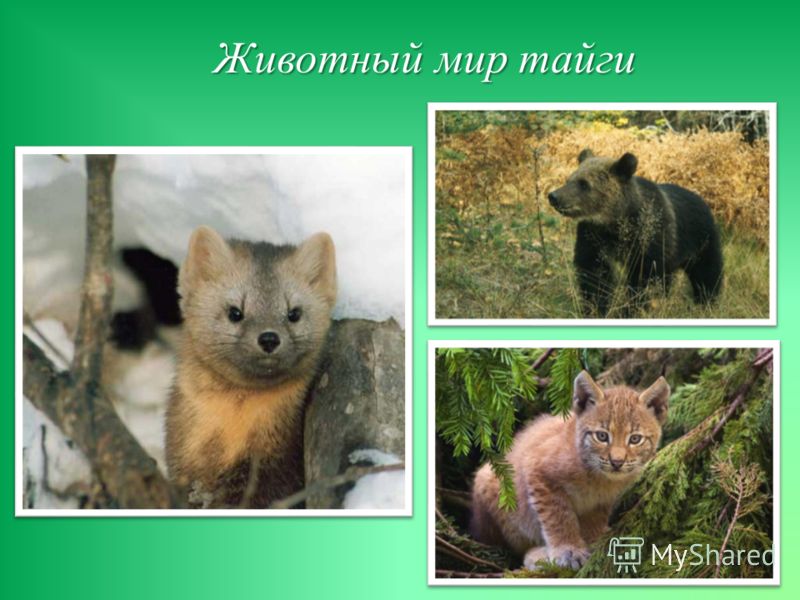
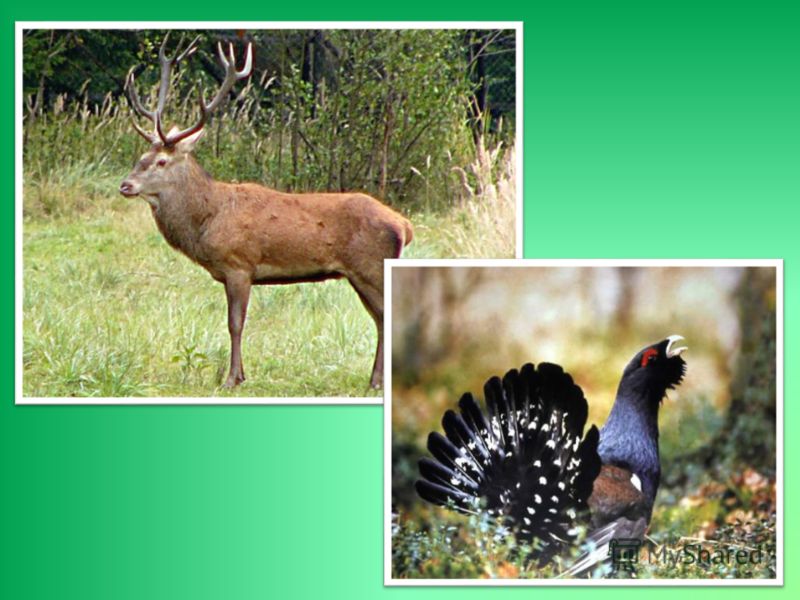
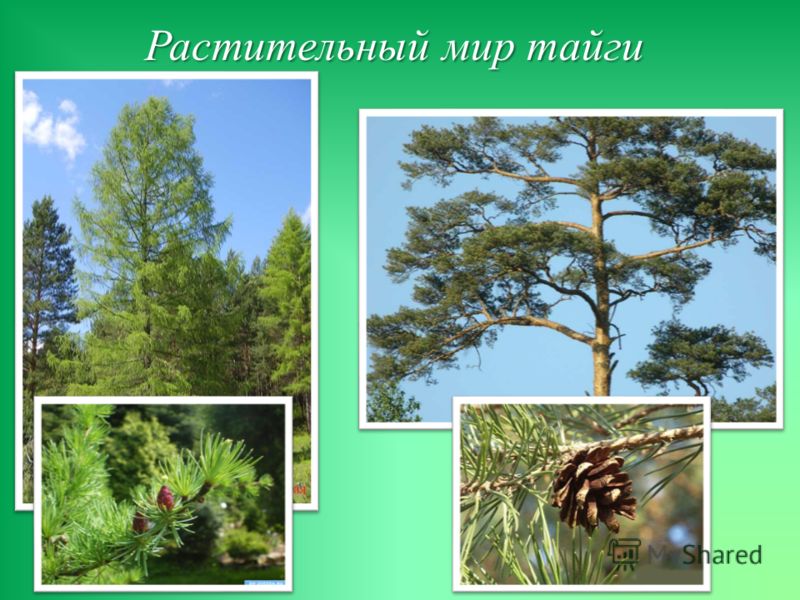
Southern taiga in the European part of Russia is being replaced mixed forests... The zone of mixed and deciduous forests has the form of a triangle, the base lying at western borders country, the top of the same abutting the Ural Mountains. The climate is moderately warm, rather humid; long, warm summer, mild winter (in the European part of the zone); Flora: oak, beech forests, birch, ash, berries and mushrooms are common. Fauna: very similar to the fauna of the taiga ...

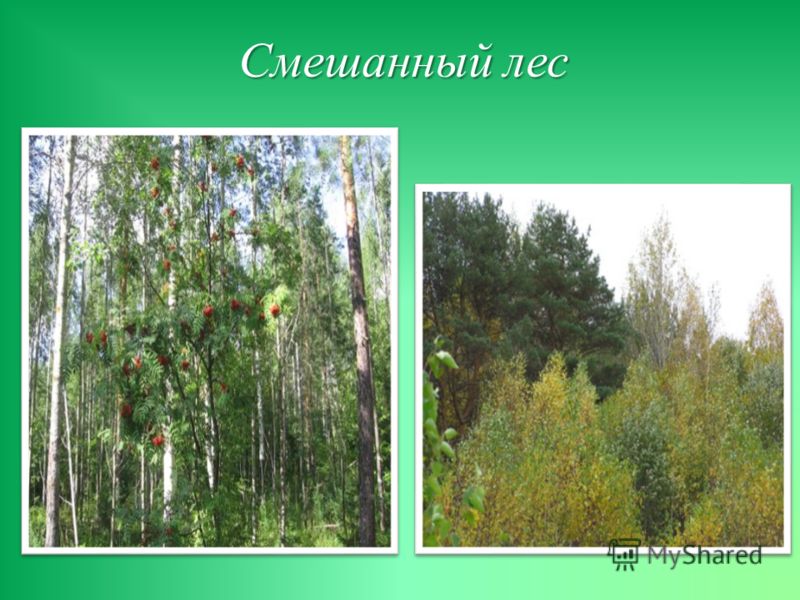
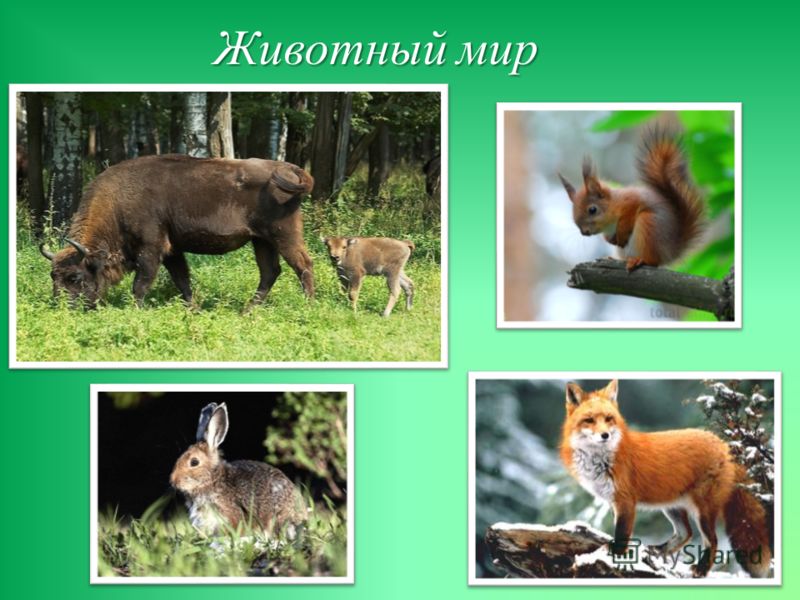
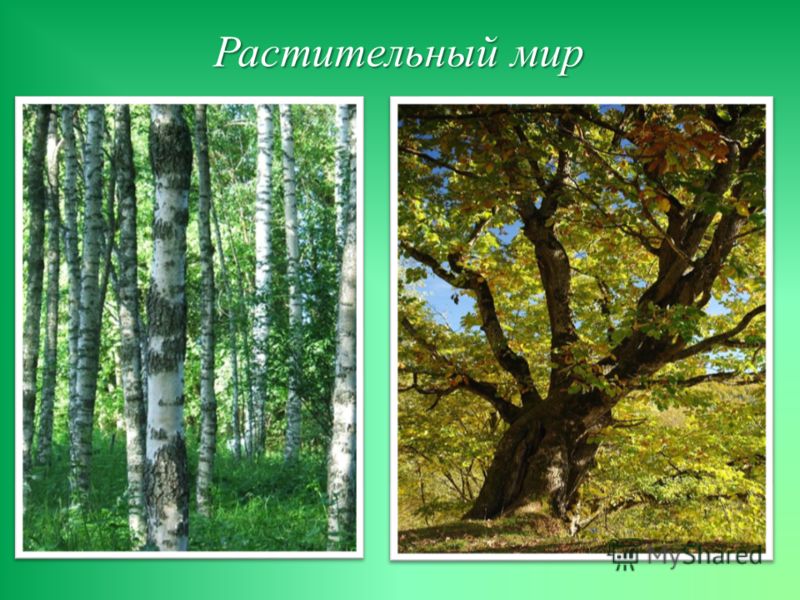
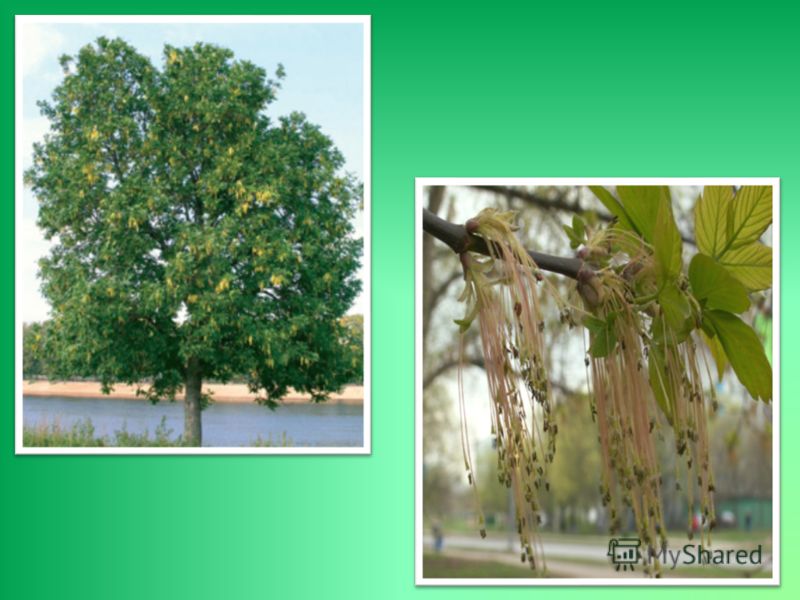
In Eurasia, the forest-steppe stretches in a continuous strip from west to east from the eastern foothills of the Carpathians to Altai. To the west and east of this strip, the continuous strike of the forest-steppe is disturbed by the influence of the mountains. Fauna: in the forest-steppe there are no special species of animals peculiar only to it. Steppe species (ground squirrel, marmot, bustard, etc.) combine and coexist here with typical forest representatives (squirrel, marten, elk). Flora: characterized by a complex alternation on the watersheds of picturesque massifs of deciduous forests (less often coniferous forests) with areas of forb steppes. In Europe and in the European part of Russia, light broad-leaved forests of oak (oak groves), beech, linden, chestnut, ash, etc. are typical.

